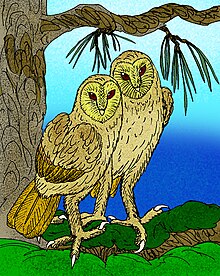Tyto pollensis anextinctgiantbarn owlwhich lived in theBahamasduring the last Ice Age.
| Tyto pollens Temporal range:Late Pleistocene
| |
|---|---|

| |
| Scientific classification | |
| Domain: | Eukaryota |
| Kingdom: | Animalia |
| Phylum: | Chordata |
| Class: | Aves |
| Order: | Strigiformes |
| Family: | Tytonidae |
| Genus: | Tyto |
| Species: | †T. pollens
|
| Binomial name | |
| †Tyto pollens | |
Description
editIt is only known from the partial remains of three individuals which have been collected on the islands ofLittle Exuma(the site was misidentified as onGreat Exumain the original literature) andNew Providence.[2][3]Alexander Wetmoreinitially described the species from fossils of a single individual from Little Exuma site which are theholotype:a complete coracoid, a proximal end of the ulna, a major metacarpal lacking the proximal end and the complete femur.[1]The femur is 81.2mm in length. Both palaeontological sites are from before the arrival of humans (theLucayans) to the islands. 18,000 years ago, the sea level was 120 metres lower than today and the Bahamas existed as at least five major islands, with a land mass over 10 times the modern size. Both dig sites would have been part of the same island. The fossil assembly of the period indicates that the Bahamas were much drier and more arid in this period, and instead of the pine forests covering the islands today, it was covered by an extensive savannah or prairie.
Ecology
editThe species wassympatricwith the American barn owl (Tyto furcata), which was much more common on the Bahamas at the time than it is today, and also had a radically different diet than today, having shifted from a diet of primarilybrown anoles(Anolis sagrei) to primarily rats andhouse micetoday. The New Providence site contained only two partial skeletons, but also copious amounts of owl pellets. These show thatT. pollenshad a diet which was largely based on the large rodentGeocapromys ingrahami,which at present only survives on a single small arid island, but which appears to have once been the only land mammal of the Bahamas and extremely common throughout most of the islands at the time. It is thought that the changing wetter climate allowed a new habitat ofBahamian pineyards(Caribbean pineforests) to spread over the islands, which drove this main prey ofT. pollensto be extirpated from all but remnant arid habitat islands, and hunting by the Lucayans may have possibly also driven the species to extinction. The Little Exuma site is from a layer not far under a darker, more organic layer showing the arrival of the Lucayans, but it was never properly dated. The New Providence site is from some 20,000 years ago, give or take.T. pollenswas closely related toT. ostologafromHispaniolaandT. noelifromCuba.T. noeliwas sympatric with an even larger species of barn owl,T. riveroi.[2][3]
Distribution and habitat
editIn a 1995 report Bruce G. Marcot, a forester from the Pacific Northwest Research Station in Portland, Oregon, claimed without evidence that it lived in theold-growthBahamian pineyards ofAndros Islandin theBahamas,[4]although the fossil assemblage indicates it was a species from the prairies and no fossils are known from Andros Island.[2][3]Marcot claimed that the owl became recently extinct due to "early human settlers". He invented a newcommon namefor the taxon: theAndros Island barn owl.He also claimed it was flightless and 1 meter tall,[4]although it was certainly not flightless nor so large.[3]One estimate posited the body mass ofT. pollensas perhaps 9.1 kg (20 lb).[5]
The chickcharney
editMarcot also claimedT. pollenslikely inspired the legend of thechickcharney,a mischievous goblin. According to legend, the Chickcharney has three-toed feet and can turn its head all the way around.[4]
See also
editReferences
edit- ^abWetmore, Alexander (1937)."Bird Remains from Cave Deposits on Great Exuma Island in the Bahamas"(PDF).Bulletin of the Museum of Comparative Zoology at Harvard College.80:427–441.
- ^abcOlson, Storrs L.; Pregill, Gregory K. (1982)."Fossil Vertebrates from the Bahamas — Introduction to the Paleontology of Bahaman Vertebrates"(PDF).Smithsonian Contributions to Paleobiology.48:1–7.Retrieved2 March2020.
- ^abcdOlson, Storrs L.; Hilgartner, William B. (1982)."Fossil Vertebrates from the Bahamas — Fossil and Subfossil Birds from the Bahamas"(PDF).Smithsonian Contributions to Paleobiology.48:36–37.Retrieved2 March2020.
- ^abcMarcot, Bruce G. (1995).Owls of old forests of the world(PDF)(Report). General Technical Reports. U.S. Department of Agriculture, Forest Service, Pacific Northwest Research Station. p. 26. PNWGTR-343.Retrieved2 March2020.
- ^Weidensaul, S. (2015).Owls of North America and the Caribbean.Houghton Mifflin Harcourt.